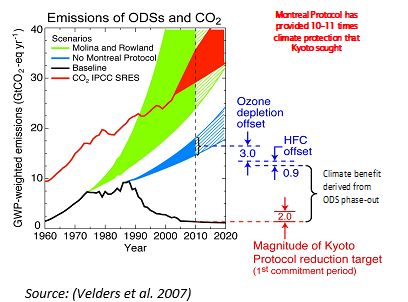MILITARY LEADERSHIP SPUN OFF TO CIVILIAN SECTORS PROTECTS GLOBAL SECURITY

Abstract
The stratospheric ozone layer protects Earth against the harmful effects of ultraviolet (UV) radiation that causes skin cancer and cataracts, suppresses the human immune system, damages agricultural crops and natural ecosystems, and deteriorates the built environment. A low carbon dioxide equivalent (CO2-eq) atmosphere protects Earth against the harmful effects of global warming, violent weather, droughts, floods, species extinction, and human mass migration. The 1987 Montreal Protocol on Substances that Deplete the Ozone Layer (Montreal Protocol) has phased out 99% of controlled ozone-depleting substances (ODSs), and the ozone layer is on the path to recovery. Because ODSs are also powerful greenhouse gases (GHGs) the phaseout protected climate so far more than all actions under other climate treaties.
In 1987 when the Montreal Protocol was agreed, every weapon and its support system worldwide depended on ODSs for manufacture, use, or service. Examples include chlorofluorocarbon (CFC) solvents for electronics and aerospace, methyl chloroform for manufacture of solid rocket motors, halon for fire protection of occupied spaces and aircraft fuel tanks, and refrigerants to cool equipment and personnel. Military organizations also used ODSs in its facilities, infrastructure, and consumer goods – in the same ways as civilian sectors.
To protect the ozone layer and to comply with the Montreal Protocol, military organizations around the world partnered internally, with each other, and with civilian organizations to avoid duplication of effort, to achieve economy of scale, and to speed commercialization through government procurement of the superior next-generation technology.
The outcome was that the technical performance of military systems was maintained or improved, costs were often reduced, and the industrial base made more resilient because militaries took advantage of this opportunity to more closely align its processes with commercial practices and eliminate military-specific practices. One measure of this extraordinary contribution to protection of the ozone layer is that military experts, organizations, and their contractors earned more United States Environmental Protection Agency (US EPA) and United Nations (UN) Awards for Implementing the Montreal Protocol than any other sector (Andersen and Gonzalez 2022; Andersen, 1998).
This paper recalls and documents the military leadership under the Montreal Protocol, presents indicative case studies of how technical performance of military systems was maintained or improved by adopting newer technologies, and summarizes key lessons from military leadership in protecting the ozone layer. In addition to collaboration on technology development and demonstration, between 1991 and 2009, military organizations from various countries came together to conduct seven workshops specifically to review military ODS uses, share experiences with alternatives, and compare policy approaches to extract and share best practices. Lessons such as this can be applied to developing and adopting technologies that displace the need to emit greenhouse gas while improving the performance of military systems and reducing operating costs.
With time running out to slow self-reinforcing feedbacks and avoid climate tipping points, it is critical that global military leadership recognize it is in their self-interest to help prevent and mitigate the worst effects of climate change. These effects on military operations and national security are well known and extensively studied. It’s not a question of if, but a question of when. It should not be difficult for the military to reclaim the constructive role they played to eliminate ODS, to catalyse worldwide partnerships, and to share the tasks of developing and deploying innovative solutions to shared technical challenges. It’s critical at this juncture for military leaders to adopt the same model with the same sense of urgency to preserve their own operational effectiveness and their own national security.
>>> Download the publication >>>
| Author(s): | Stephen O. Andersen, E. Thomas Morehouse, Atul Bagai, and David King |
| Publisher(s): | Global Military Advisory Council on Climate Change |
| Place Published: | The Hague / Washington, D.C. |
| Date / Journal Vol. No.: | 30 March 2023 |
| Pages: | 35 |